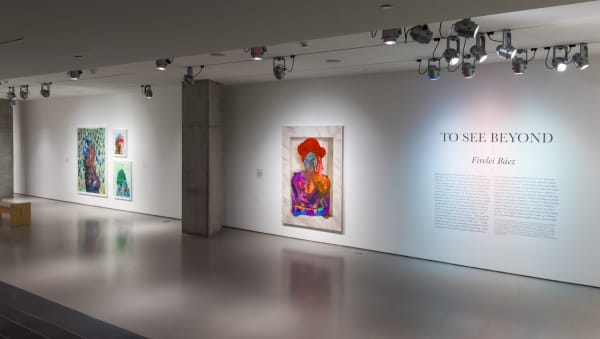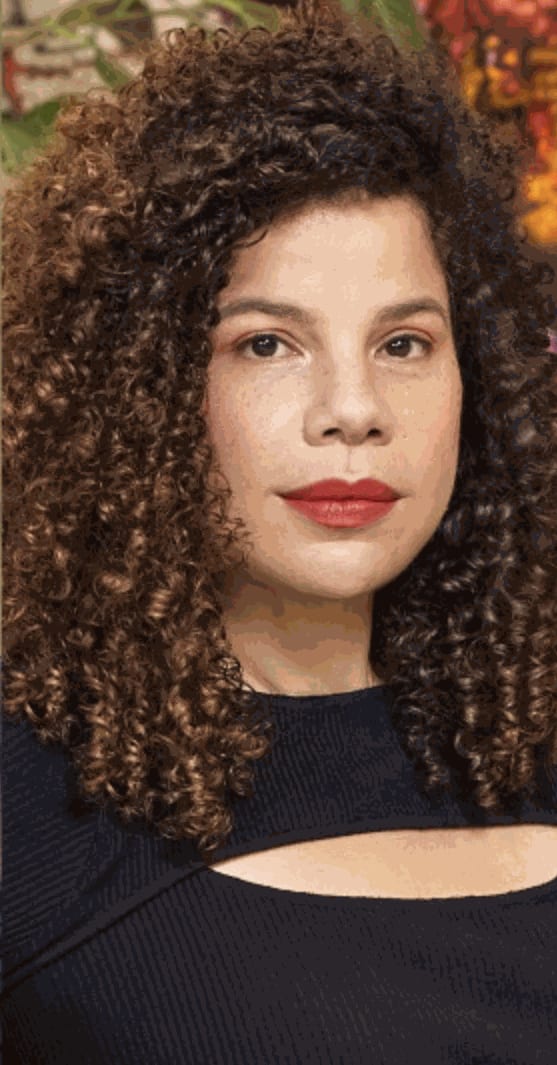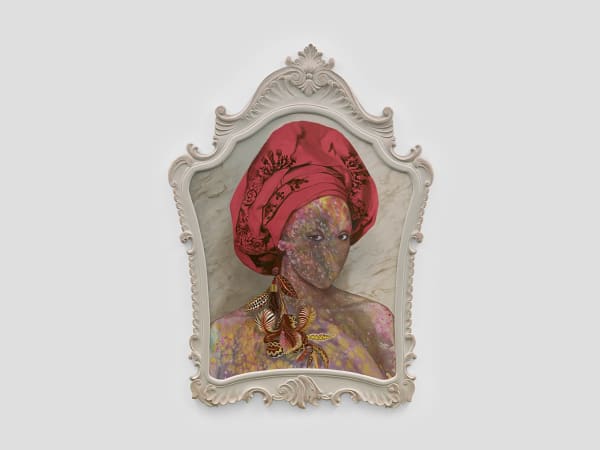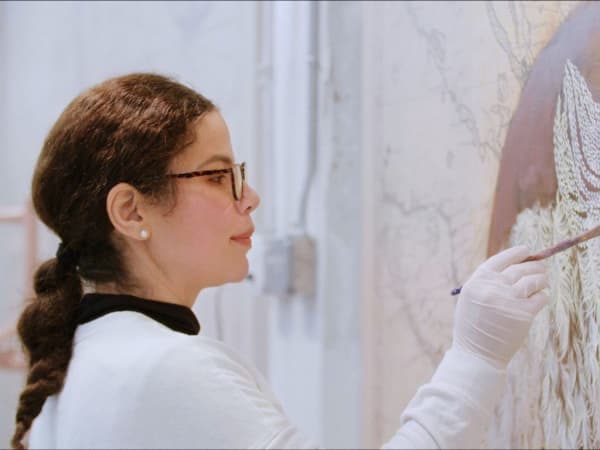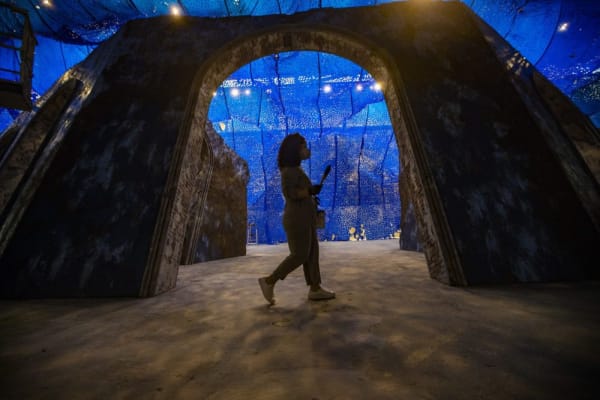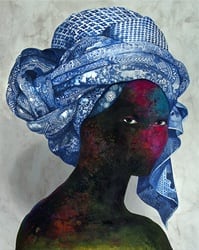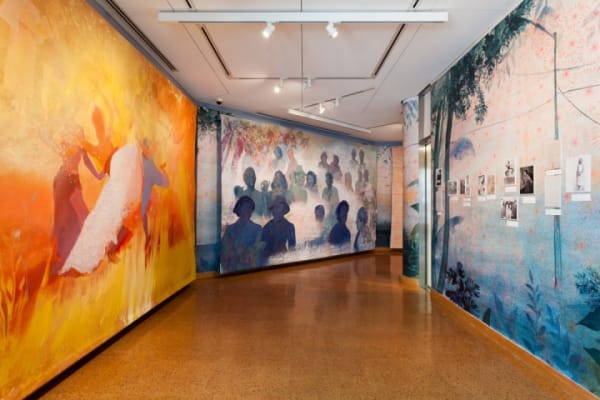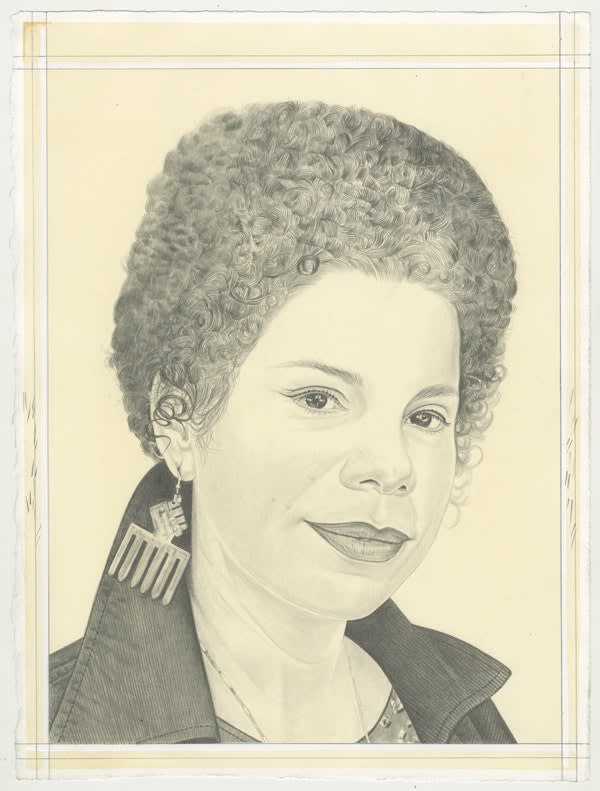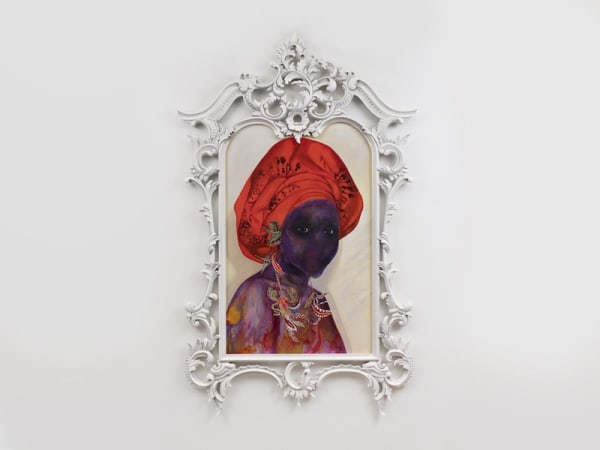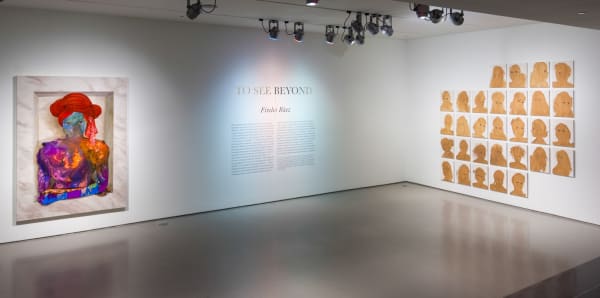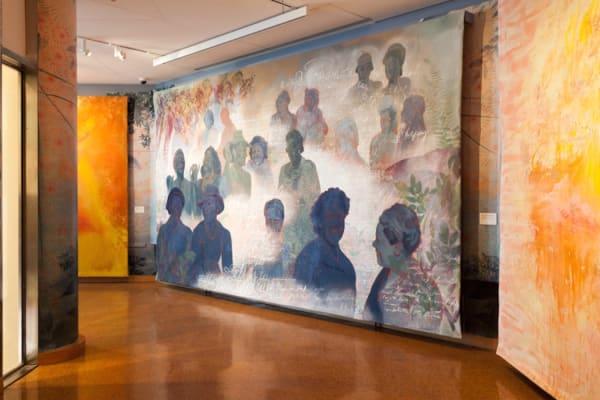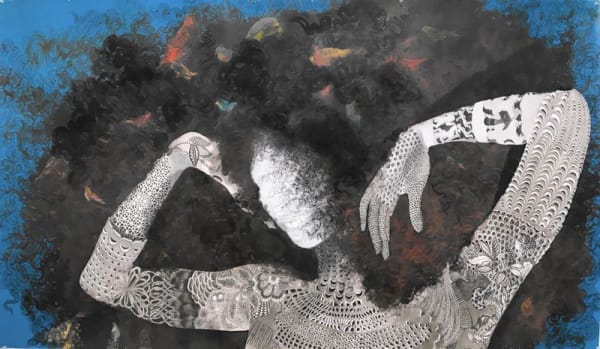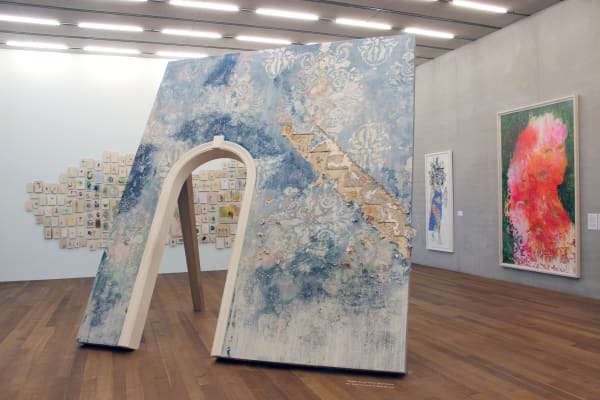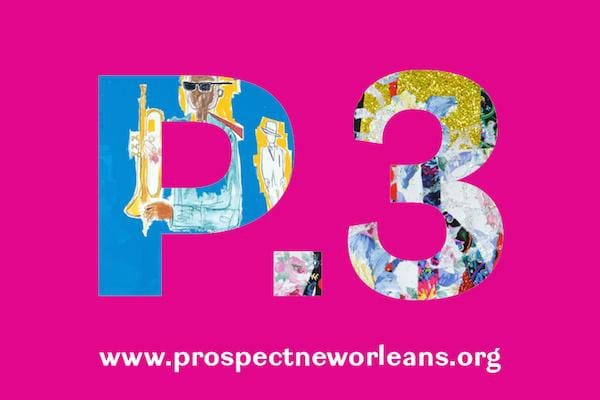Firelei Báez Dominican Republic, b. 1980
Firelei Báez is interested in how culture and identity are shaped by inherited histories. Her work reveals the incomplete nature of our communal stories while constructing more egalitarian social narratives so a more equitable future might emerge.
Portraiture is a key aspect of Báez’s work. She sees the human body as the most direct link between artist, viewer, and subject. Across the mediums of painting, sculpture, drawing and installation, she layers strong, confident, imaginative portraits of Afrodiasporic figures over physical and conceptual echoes of the past. In her portraits, aspects of her personal identity are evident, revealing the intense personal connection Báez feels to the stories she is telling.
Materially, Báez makes work that looks both old and new. She sometimes achieves this aesthetic using traditional materials like acrylic paint on canvas, but more often paints her images directly onto found materials, such as pages from old scientific manuals, travelogues, or biographies of political figures published during key historical moments. On these surfaces, Báez layers the fabric of the past with visions of a newly imagined present. This is the meeting place of past, present, and future, where she creates what art historian Portia Malatjie called “a space of possibility, a space where fictional alternative universes are imagined, often with strong female protagonists.”
The inescapable conclusion Báez exposes is that history is not fixed. Her latest works continue her ongoing examination of historical narratives, focusing particularly on issues surrounding territory, industry, and what it means to be a “true, blue” American. These works are unique, but are also part of a continual unfolding, a process of revelation transpiring in exhibitions from Venice and Berlin to New York and Chicago.
Each exhibition is one new point of access to a much larger field of discovery—what Báez calls a “third space of refuge,” where forgotten history can be recalled and new paths forward can be imagined. By untying and re-tying the knots of history, she hopes to create a generative, productive space, where the bellicose ledger of the past can make way for new accounts of what we hope to become and where individual viewers can search for themselves.
Major exhibitions of Báez work include Firelei Báez, ICA/Boston Watershed Commission, Institute of Contemporary Art, Boston, MA; Artes Mundi 9, National Museum, Cardiff, Wales; Firelei Báez, Mennello Museum of American Art, Orlando, FL, USA; Firelei Báez, Witte de With Center for Contemporary Art, Rotterdam, NL; Joy Out of Fire, Studio Museum in Harlem, NY, USA; Firelei Báez: Bloodlines, Pérez Art Museum Miami (PAMM), FL, USA; 10th Berlin Biennial, Berlin, DE; Firelei Báez: How To Slip Out Of Your Body Quietly, Kavi Gupta, Chicago, IL, USA; Firelei Báez: Bloodlines, Andy Warhol Museum, Pittsburgh, PA, USA; and The Modern Window, MoMA, New York, NY, USA. Báez has received numerous awards, including the Herb Alpert Award in the Arts 2020; Soros Arts Fellowship 2019; United States Artists Fellowship 2019; Institute of Contemporary Art Boston Watershed Artist 2019; College Art Association Artist Award for Distinguished Body of Work 2018; Future Generation Art Prize 2017; Chiaro Award 2016; and Joan Mitchell Painters & Sculptors Grant 2011. Her work belongs to the permanent collections of such institutions as the Studio Museum in Harlem, New York, NY; Kemper Art Museum, St. Louis, MO; PAMM, Miami, FL; Cleveland Clinic Fine Art Collection, Cleveland, OH; Phillip and Tracey Riese Foundation, New York, NY; San Jose Museum of Art, San Jose, CA; Ruth and Elmer Wellin Museum of Art, Hamilton College, Clinton, NY; Sindika Dokolo Foundation Collection, Luanda, Angola; Spelman College Museum of Fine Art, Atlanta, GA; and Salomon Foundation for Contemporary Art, Annecy, France.
Báez lives and works in New York, NY.
-
 Firelei BáezMagnitude and Bond, 2018Acrylic/Oil on canvas, Custom Made, Foldable Aluminum Stretchers108 x 192 in
Firelei BáezMagnitude and Bond, 2018Acrylic/Oil on canvas, Custom Made, Foldable Aluminum Stretchers108 x 192 in
274.3 x 487.7 cm -
 Firelei BáezLuminously Indiscreet, 2018Acrylic on canvas108 x 192 in
Firelei BáezLuminously Indiscreet, 2018Acrylic on canvas108 x 192 in
274.3 x 487.7 cm -
 Firelei Báezroots when they are young and most tender, 20182 paintings, 4-6 hand painted papier-mâché sculptures, 40’x30’ hand painted blue tarp, chicken wire and foliagedimensions variable
Firelei Báezroots when they are young and most tender, 20182 paintings, 4-6 hand painted papier-mâché sculptures, 40’x30’ hand painted blue tarp, chicken wire and foliagedimensions variable -
 Firelei BáezStudy in Blue (We have come to stir the other world, to cleanse ourselves, to connect our living to the dead here), 2018Acrylic and ink on canvas with painted tarp8 x 20 in
Firelei BáezStudy in Blue (We have come to stir the other world, to cleanse ourselves, to connect our living to the dead here), 2018Acrylic and ink on canvas with painted tarp8 x 20 in
20.3 x 50.8 cm -
 Firelei BáezI write love poems, too (The right to non-imperative clarities), 2018Acrylic, ink, and chine-collé on deaccessioned book pages96 x 224 in
Firelei BáezI write love poems, too (The right to non-imperative clarities), 2018Acrylic, ink, and chine-collé on deaccessioned book pages96 x 224 in
243.8 x 569 cm -
 Firelei BáezConstellation (Movements reimagined), 2019Oil and Acrylic on canvas40 x 30 x 2 in
Firelei BáezConstellation (Movements reimagined), 2019Oil and Acrylic on canvas40 x 30 x 2 in
101.6 x 76.2 x 5.1 cm
-

Firelei Báez
Crystal Bridges Museum of American Art 16 Jul 2023In her largest sculptural installation to date, Firelei Báez invites visitors to traverse passageways and travel through time and space, engaging with streams of intervention and interconnectedness. In its second...Read more -

Devan Shimoyama, Firelei Baéz And Mickalene Thomas, When We See Us: A Century Of Black Figuration In Painting
Zeitz Museum of Contemporary Art Africa, Cape Town, South Africa 20 Nov 2022 - 3 Sep 2023When We See Us: A Century of Black Figuration in Painting comprises an exhibition, publication and discursive programming that explores Black self-representation and celebrates global Black subjectivities and Black consciousness...Read more -

Jeffrey Gibson & Firelei Báez in Dialogues Across Disciplines
Ruth and Elmer Wellin Museum of Art | Hamilton College, Clinton, NY 17 Sep 2022 - 20 May 2023Dialogues Across Disciplines celebrates the ten year anniversary of the Ruth and Elmer Wellin Museum of Art. Featuring a selection of artworks acquired through gifts and purchases over the last...Read more -

Firelei Báez, The Milk of Dreams
The 2022 Venice Biennale 23 Apr - 27 Nov 2022The 59th International Art Exhibition, titled The Milk of Dreams and curated by Cecilia Alemani, is organised by La Biennale di Venezia chaired by Roberto Cicutto. The Pre-opening will take...Read more -

Firelei Báez in Shifting the Silence
San Francisco Museum of Modern Art, San Francisco, CA 7 Apr - 5 Sep 2022Shifting the Silence features dynamic works by thirty-two women artists who use the radical language of abstraction to enhance our understanding of the world we inhabit. Named after artist Etel...Read more -

Firelei Báez, MCA Atrium Project
Museum of Contemporary Art Chicago 26 Mar 2022 - 9 Apr 2023In the latest iteration of the MCA Chicago's Atrium Project , Firelei Báez (b. 1981, Santiago de los Caballeros, Dominican Republic; lives and works in New York) fills the museum's...Read more -

Firelei Baéz in, Abstracted Migrations: Ideas on Embodied Motion
Moore College of Art & Design | Philadelphia, PA 2 Oct - 4 Dec 2021On view October 2 - December 4, visiting curator Kalia Brooks presents Abstracted Migrations: Ideas on Embodied Motion in The Galleries at Moore. The exhibition features the work of three...Read more -

Manuel Mathieu and Firelei Báez in Fragments of Epic Memory
Art Gallery of Ontario | Ontario, CA 1 Sep 2021 - 21 Feb 2022Fragments of Epic Memory will invite visitors to experience the multiple ways of encountering the Caribbean and its diaspora, from the period following emancipation through today. The first exhibition organized...Read more -

Firelei Báez, ICA Watershed
Boston Harbor Shipyard and Marina | East Boston, MA 3 Jul - 6 Sep 2021In summer 2021, the ICA Watershed will feature a newly commissioned, monumental sculpture by acclaimed artist Firelei Báez. In her largest sculptural installation to date, the artist reimagines the archeological...Read more -

Firelei Báez, Artes Mundi 9
National Museum | Cardiff, Wales 19 May - 5 Sep 2021Although the shortlist was first confirmed in September 2019—at a time when few could predict the global pandemic that the world was accelerating towards—it is no coincidence that the artists...Read more -

Now Is The Time: Recent Acquisitions to the Contemporary Collection
Baltimore Museum of Art | Baltimore, MD 2 May - 18 Jul 2021In 2018, the BMA deaccessioned seven artworks from its contemporary holdings to create an acquisition fund for purchases of works by artists underrepresented in its collection and within broader art...Read more -

Firelei Báez, Immersion into Compounded Time
Mennello Museum of Art | Orlando, FL 2 Jul - 1 Sep 2019The Mennello Museum of American Art is pleased to present IMMERSION INTO COMPOUNDED TIME AND THE PAINTINGS OF FIRELEI BÁEZ . The exhibition will be on view at the Mennello...Read more -

Firelei Báez, On the High Line En Plein Air
The High Line | NYC 1 May 2019 - 1 May 2020En Plein Air , inspired by the unique site of the High Line, examines and expands the tradition of outdoor painting. The title refers to the mid-19th century practice of...Read more -

FIXED CONTAINED, Curated by Tomokazu Matsuyama
Kotaru Nukaga | Tokyo, Japan 20 Apr - 29 Jun 2019KOTARO NUKAGA is pleased to present FIXED CONTAINED, a group exhibition of seven international contemporary artists: Brian Alfred, Firelei Báez, Inka Essenhigh, Nir Hod, Tony Matelli, Tomokazu Matsuyama, and Carlos...Read more -

Idea Sale
Kavi Gupta | 219 N. Elizabeth St. Chicago, IL, 60607 13 Apr - 1 Jun 2019Kavi Gupta is pleased to present Idea Sale, a group exhibition of original works by Glenn Kaino, Jae Jarrell, Wadsworth Jarrell, Manish Nai, Scott Reeder, Tony Tasset, José Lerma, Jessica Stockholder, and Angel Otero.Read more -

Firelei Báez, New Work
Witte de With Center for Contemporary Art | Rotterdam, Netherlands 27 Jan - 12 May 2019In this exhibition, a new body of work is presented featuring three paintings and a immersive installation manifest from the artist’s research on the Haitian Revolution (1791-1804) and its enduring significance.Read more -

Firelei Báez, How to Slip Out of Your Body Quietly
Kavi Gupta | 835 W. Washington St. Chicago, IL, 60607 15 Sep - 14 Nov 2018Kavi Gupta Gallery presents its first solo exhibition of new work by Dominican-American artist Firelei Báez, whose monumental installation at the recent 10th Berlin Biennale and concurrent solo exhibition at the Studio Museum in Harlem continue to receive international acclaim.Read more -

Parallel Lives
Kavi Gupta | 835 W. Washington St. Chicago, IL, 60607 16 Jun - 24 Aug 2018Kavi Gupta is pleased to present Parallel Lives. This group exhibition brings a diverse selection of contemporary artists working in figuration and portraiture: Firelei Baez, Alfred Conteh, Inka Essenhigh, Jeffrey Gibson, Glenn Kaino, Titus Kaphar, Basil Kincaid, & Devan Shimoyama. Each artist approaches the motif through unique technical applications and each has their own personal conceptual goals, however, the exhibition seeks to unite how the human subject in art serves as a channel between artist and audience, or audience to audience.Read more -

Firelei Báez, Berlin Biennale
Akademie der Künste | Berlin, Germany 6 Jun - 9 Sep 2018Kavi Gupta congratulates Firelei Báez on her participation in the 10th Berlin Biennale.Read more -

Firelei Báez, To See Beyond
Contemporary Art Center | Cincinnati, OH 18 May - 19 Aug 2018"There's a fluidity of color, of race, in the Caribbean … In America, you're black.” Caribbean-born, Brooklyn-based artist Firelei Báez navigates a broad spectrum of color, race and identity in her first Ohio exhibition.Read more -

Firelei Báez, Joy Out Of Fire
The Studio Museum in Harlem in partnership with the Schomburg 1 May - 24 Nov 2018Firelei Báez: Joy Out of Fire continues the artist’s longstanding interest in representations of women, particularly Afro-Caribbean/Afro-Latina women in visual culture and history. In this exhibition, Báez features women whose...Read more -

Firelei Báez, Vessels of Genealogies
DePaul Art Museum | Chicago, IL 17 Apr - 6 Aug 2017Firelei Báez is a Dominican-American artist whose large-scale paintings, drawings, and textiles evoke the beauty and political implications of hairstyles, textiles, and tattoos for those whose cultural identities have remained...Read more -

Firelei Báez, Bloodlines
The Andy Warhol Museum | Pittsburgh, PA 17 Feb - 21 May 2017Firelei Báez: Bloodlines is organized by Pérez Art Museum Miami Assistant Curator María Elena Ortiz.Read more -

Firelei Báez, Bloodlines
Pérez Art Museum | Miami, FL 15 Oct 2015 - 6 Mar 2016Tracing the history of social movements in the Unites States and the Caribbean, Bloodlines presents a series of new works by Firelei Báez (b. 1981, Santiago de los Caballeros, Dominican Republic; lives in New York) inspired by lineages of black resistance.Read more
-

Firelei Báez: Market 5 Artworks for Every Level of Collector at Art Basel
Anna Sansom, Art Net, June 15, 2023 -

Firelei Báez: Art Basel Conversations
Art Basel , May 26, 2023 -

Firelei Báez: Chorus of the Deep
Rebecca Rafferty, City Magazine, May 26, 2023 -

Firelei Báez: MoMA Reinterpreting Latin America's Colonial History
Buenos Aires Times, May 5, 2023 -

Making and Giving Space with Firelei Báez
Smithsonian , April 26, 2023 -

Kavi Gupta: The Best Shows to See in Chicago Right Now
Lisa Yin Zhang, FRIEZE, April 13, 2023 -

Firelei Báez: Ethics in Public Art
Mon. Mar 13, 2023 6:30pm - 7:30pm EDT, The New York Public Library , March 7, 2023 -

Mickalene Thomas, Richard Hunt, Firelei Báez: The 18 Best Black Art Books of 2022
Victoria L. Valentine, Culture Type, January 3, 2023 -

Firelei Báez: 6 Things Galerie Editors Love This Week
Galerie, January 3, 2023 -

FIRELEI BÁEZ CELEBRATES THE CARIBBEAN DIASPORA
Art Basel, December 29, 2022 -

‘Beauty Can Be Subversive’: Watch Artist Firelei Báez Reclaim Dominican Folklore in Her Richly Layered Paintings
ArtNet News, December 29, 2022 -

Mickalene Thomas, Devan Shimoyama, & Firelei Báez: ZEITZ MOCAA × GUCCI – WHEN WE SEE US
360, November 20, 2022 -

Firelei Báez: FRONT Triennial exhibits at Cleveland Museum of Art explore artistic vision, healing, community, and joy
Steven Litt, Cleveland.com, July 24, 2022 -

Firelei Báez: A Behemoth New Book Surveys a Broad Segment of Millennial Artists Working Today
Grace Ebert, Colossal, May 12, 2022 -

Firelei Baez: See Practically Every Artwork in the Venice Biennale’s Arsenale Section
Ben Davis, ArtNet News, April 21, 2022 -

Firelei Báez Brings an Afrofuturist Empire in the Atlantic to the MCA Chicago
Tessa Solomon, ARTnews, April 7, 2022 -

FIRELEI BÁEZ IN THE VENICE BIENNALE 2022
ALEX GREENBERGER, ARTNEWS, February 2, 2022 -

Reflecting on our favorite arts and culture moments of 2021
Tania Ralli, Dianna Bell, Cristela Guerra, Andrea Shea, Amelia Mason, Arielle Gray, Magdiela Matta, WBUR, December 21, 2021 -

Artist Explores History Of Indigo In Exhibit Inspired By Haiti
Cristela Guerra, WBUR Boston, July 14, 2021 -

In Boston, Art That Rises From the Deep
Siddhartha Mitter, New York Times, July 2, 2021 -

Haiti’s revolutionary past rises at the ICA Watershed
Murray Whyte, Boston Globe, May 21, 2021 -

Amazing exhibitions to see as we head #BackToMuseums
Eleanor Mills, Museums Association, May 14, 2021 -

Game-Changing Artists and Curators of Color Showcased in New Book
Maximilíano Durón, ARTnews, February 3, 2021 -

FIRELEI BÁEZ AMONG 2020 HERB ALPERT AWARD WINNERS — ARTFORUM, 05.27.2020
Artforum, May 27, 2020 -

FIRELEI BÁEZ’S TIME AND SPACE
Hilarie M. Sheets, Cultured, May 17, 2020 -

On View: Firelei Báez Explores Diasporic Histories, Mythical Figures, and Imagined Realms at James Cohan Gallery in New
Victoria L. Valentine, Culture Type, May 8, 2020 -

BOSTON’S ICA SELECTS FIRELEI BÁEZ FOR THIRD WATERSHED COMMISSION
ARTFORUM, October 11, 2019 -

DOMINICAN MULTIMEDIA ARTIST FIRELEI BÁEZ NAMED ICA WATERSHED ARTIST FOR 2020
Chris Triunfo, The Boston Globe, October 10, 2019 -

Artes Mundi Prize Shortlist Announced, 6 Artists Include Carrie Mae Weems, Firelei Báez, and Dineo Seshee Bopape
Victoria L. Valentine, Culture Type, September 27, 2019 -

NAVIGATING THE PORTALS BETWEEN WORKS BY LIGIA LEWIS AND FIRELEI BAEZ — DIXA RAMÍREZ D'OLEO
Dixa Ramírez D'oleo, HYPERALLERGIC, September 26, 2019 -

FIRELEI BÁEZ AT THE MENNELLO MUSEUM OF AMERICAN ART
Jean Marie Carey, Arte Fuse, July 2, 2019 -

FIRELEI BÁEZ’S INTOXICATING INSTALLATION IS A FEMINIST ODE TO THE AFRICAN DIASPORA
Julia Wolkoff, Artsy, May 3, 2019 -

OPEN SOCIETY FOUNDATION NAMES WINNERS OF 2019 SOROS ARTS FELLOWSHIPS
Annie Armstrong, Artnews, April 25, 2019 -

LEXICON: THE LANGUAGE OF GESTURE IN 25 YEARS AT KEMPER MUSEUM
Breeze Richardson, Cision PRWEB, April 24, 2019 -

ARTIST PROPOSALS FOR SHIRLEY CHISHOLM MONUMENT IN NEW YORK REVEALED
Claire Selvin, ARTnews, March 27, 2019 -

SEE THE FIVE ARTIST PROPOSALS FOR NYC’S SHIRLEY CHISHOLM MONUMENT
Zachary Small, HYPERALLERGIC, March 27, 2019 -

SEE PROPOSALS BY MICKALENE THOMAS, FIRELEI BÁEZ, AND OTHERS FOR A MONUMENT TO THE FIRST BLACK WOMAN TO SERVE IN CONGRESS
Sarah Cascone, Artnet News, March 27, 2019 -

NEXT UP ON THE HIGH LINE IN NEW YORK: PAINTINGS
Annie Armstrong, ARTnews, February 5, 2019 -

UNITED STATES ARTISTS NAMES 2019 FELLOWS, INCLUDING FIRELEI BÁEZ, WU TSANG, AND CECILIA VICUÑA
Alex Greenberger, ART NEWS, January 22, 2019 -

STUDIO VISIT: FIRELEI BÁEZ
Isabel Custodio, MOMA Magazine, November 14, 2018 -

REDRAWING THE HISTORY OF WOMEN OF COLOR IN VIBRANT HUES
Julia Friedman, HYPERALLERGIC, November 7, 2018 -

FIRELEI BÁEZ WITH HỒNG-ÂN TRƯƠNG
Hồng-Ân Trương, The Brooklyn Rail, November 1, 2018 -

EVEN AS BREXIT LOOMS, GALLERIES NOTCH SALES ON FRIEZE LONDON’S OPENING DAY (EXCERPT)
Judd Tully, ARTnews, October 3, 2018 -

CHICAGO EXPO HIGHLIGHTS ART, DESIGN, AND ARCHITECTURE THROUGHOUT THE WINDY CITY (EXCERPT)
Brook Mason, Architectural Digest, September 28, 2018 -

WHAT NOT TO MISS AT FRIEZE LONDON (EXCERPT)
Adam Heardman, Mutual Art, September 26, 2018 -

HOW FIRELEI BÁEZ USES YORUBA ICONS AND HER AFRO-CARIBBEAN HERITAGE IN HER PROFOUND ‘JOY OUT OF FIRE’ MURALS
Jasmin Hernandez, Artnet News, September 14, 2018 -

TWO NEW SHOWS AT CONTEMPORARY ARTS CENTER LOOK AT IDENTITY FROM DIFFERENT ANGLES
Leyla Shokoohe, City Beat, July 9, 2018 -

AN ARTIST FINDS INSPIRATION IN WOMEN OF COLOR THROUGHOUT HISTORY
Tess Thackara, New York Times Style, June 19, 2018 -

THE POWERFUL WOMEN OF FIRELEI BÁEZ
Roxana Fabius, Contemporary AND, May 15, 2018 -

FIRELEI BÁEZ – BERLIN BIENNALE
April 28, 2018 -

BERLIN BIENNALE RELEASES ARTIST LIST FOR TENTH EDITION
ART FORUM, April 25, 2018 -

HERE’S THE FULL LIST OF PARTICIPATING ARTISTS FOR THE 10TH BERLIN BIENNALE
Kate Brown, ART NET, April 25, 2018 -

ARTIST LIST FOR 10TH EDITION
E-Flux, April 25, 2018 -

COLLEGE ART ASSOCIATION ANNOUNCES 2018 AWARDS FOR DISTINCTION (EXCERPT)
ARTnews, January 26, 2018 -

FIRELEI BAEZ’S STIRRING, NEW MEDITATIONS ON FEMININITY
Andy Smith, HI-Fructose, December 15, 2017 -

AT THE KEMPER, A ‘TREASURE HUNT’ LEADS FROM COLONIAL LOUISIANA TO TODAY’S KANSAS CITY
Vicky Diaz-Camacho, KCUR NPR Kansas City, August 25, 2017 -

FIRELEI BAEZ ON GENEROSITY AND FREEDOM IN ART
Asterix Journal, July 6, 2017 -

THIS IS WHAT INTERSECTIONAL FEMINIST ART LOOKS LIKE
Lori Waxman, Chicago Tribune, June 21, 2017 -

Firelei Baez: Bloodlines tackles race, gender and history at The Warhol
Amani Newton, Pittsburgh City Paper, April 19, 2017 -

IN CONVERSATION WITH FIRELEI BÁEZ: HER WONDROUS EXIHIBIT ‘BLOODLINES’ AND HER EXPLORATION OF BLACK WOMANHOOD
Jasmin Hernandez, Gallery Gurls, March 1, 2017 -

FIRELEI BÁEZ’S COMPLEX STUDIES OF FEMALE IDENTITY SHOW WHY SHE’S AN ARTIST FOR OUR TIME
Jared Quinton, Artsy, February 9, 2016 -

FIRST LOOK: FIRELEI BÁEZ
Art in America, Wendy Vogel, December 17, 2015 -

FIRELEI BÁEZ’S STUNNING PAMM EXHIBIT, “BLOODLINES,” DISSECTS COMPLEX RACIAL IDENTITIES
Stassa Edwards, Miami New Times, December 1, 2015 -

UTAH MUSEUM EXHIBITS ART OF AWARD-WINNING PAINTER
Mikey Kettinger, Utah Public Radio, October 13, 2015 -

PROSPECT.3: NOTES FOR NOW IN NEW ORLEANS
Paul Laster, WhiteHot Magazine, November 1, 2014 -

ART REVIEW: FIRELEI BAEZ AT RICHARD HELLER GALLERY
Holly Myers, LA TIMES BLOG, April 14, 2012
-

Frieze London 2019
3 - 6 Oct 2019Read more -

Art Basel Miami Beach 2018
6 - 9 Dec 20182018 has been a landmark year for AFRICOBRA (African Commune of Bad Relevant Artists), which was founded in Chicago in 1968 and defined the aesthetic...Read more -

Frieze London 2018
4 - 7 Oct 2018We are thrilled to announce that Kavi Gupta will participate in FRIEZE ART FAIR London 2018. Our curation for this vital international art fair embodies...Read more -

The Armory Show 2018
8 - 11 Mar 2018For the Armory Show, Kavi Gupta will debut parts of our exciting 2018 program with a diverse selection of artists. Highlights will include works by...Read more
-

Artes Mundi 9: Firelei Báez (Yn Gymraeg)
April 8, 2022Read more -

Artist Interview: Firelei Baez | ICA Teens
October 8, 2021Read more -

Firelei Báez on PBS News Hour
July 15, 2021Read more -

Firelei Báez at the ICA Watershed | ICA/Boston
June 28, 2021Read more -

Artes Mundi 9: Firelei Báez
May 17, 2021Read more -
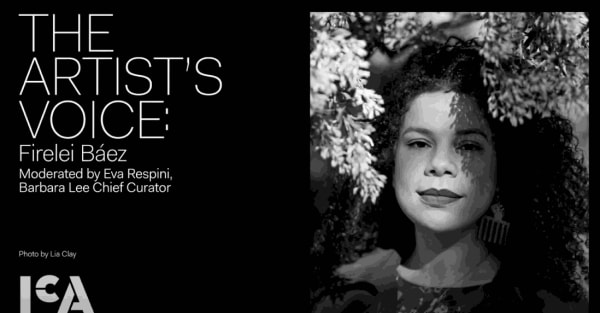
The Artist's Voice: Firelei Báez | ICA Boston
May 11, 2021Read more -

Art21: Firelei Báez: An Open Horizon (or) the Stillness of a Wound | Art21 “New York Close Up”
February 1, 2021Where can beauty be subversive? Working in her Bronx studio, artist Firelei Báez creates a series of paintings that draw upon the rich folklore and...Read more -

Bronx Museum | Meet The Artist: Firelei Baez
March 30, 2020Read more -
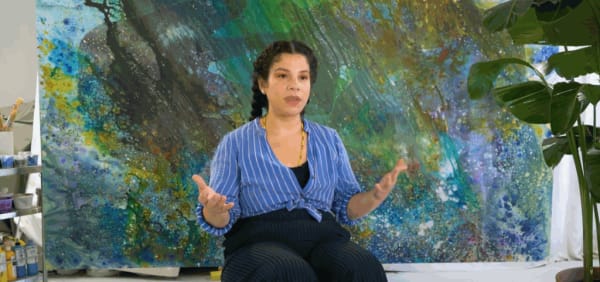
A Closer Look with Firelei Báez | Baltimore Museum of Art
November 7, 2019Read more -
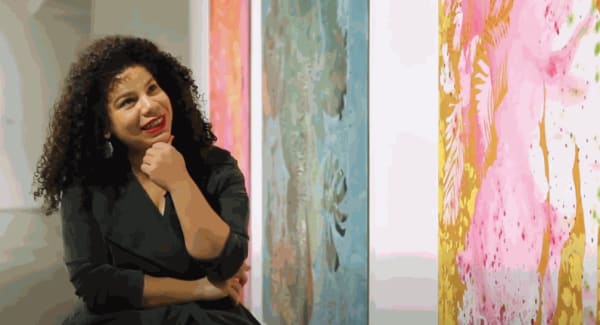
Firelei Báez | 6 QUESTIONS | CincyCAC
October 4, 2019Read more -

Artist in Conversation: Firelei Báez & Pamela Joyner | Smithsonian MOAD
July 12, 2019Read more -
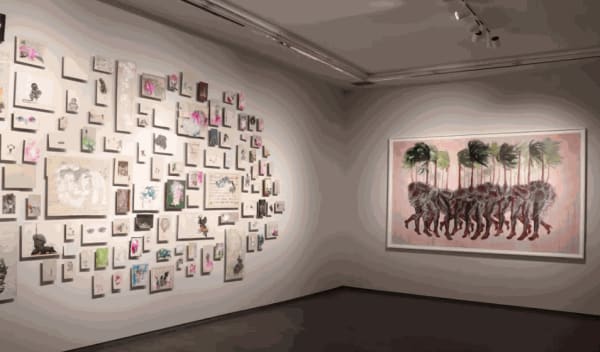
Firelei Báez - How to slip out of your body quietly
November 6, 2018Read more -

Firelei Baez: Bloodlines at The Andy Warhol Museum
April 14, 2017Read more -

Firelei Báez: Future Generation Art Prize
March 13, 2017Read more
-
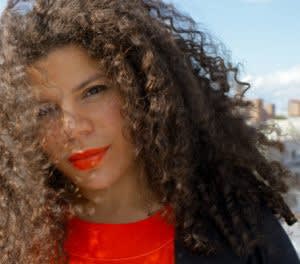
FIRELEI BÁEZ AWARDED UNITED STATES ARTISTS GRANT
01.23.19Each year, Chicago based United States Artists awards up to 50 unrestricted grants of $50,000 to artists of all disciplines working in the United States. This year, Firelei Báez is amongst the 45 grantees.Read more -

DON’T MISS: FIRELEI BÁEZ AT THE STUDIO MUSEUM IN HARLEM
07.11.2018We want to take a moment to express our gratitude for all of the encouraging press that has been coming out ever since Firelei Báez:...Read more -

FIRELEI BÁEZ AT THE BERLIN BIENNALE
06.26.2018We’re so proud of Firelei Báez for her contribution to this year’s Berlin BiennaleRead more


























